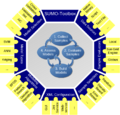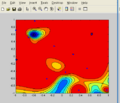About
History
In 2004, research within the COMS group was focused on developing efficient, adaptive and accurate algorithms for polynomial and rational modeling of linear time-invariant (LTI) systems. This work resulted in a set of Matlab scripts that were used as a testing ground for new ideas and techniques. Research progressed, and with time these scripts were re-worked and refactored into one coherent Matlab toolbox, tentatively named the Multivariate MetaModeling (M3) Toolbox. The first public release of the toolbox (v2.0) occurred in November 2006.
What is it used for
Global Surrogate Models
The M3-Toolbox was designed to solve the following problem:
In addition the toolbox provides powerful, adaptive algorithms and a whole suite of model types for
- data fitting problems (regression)
- response surface modeling
- interpolation
- optimal experimental design (also known as adaptive sample selection or active learning)
For an application scientist or engineer the toolbox provides a flexible, pluggable platform to which response surface modeling can be delegated. For researchers in surrogate modeling it provides a common framework to implement, test and benchmark new modeling and sampling algorithms.
See the Wikipedia Surrogate model page to find out more about these types of models.
Surrogate Driven Optimization
While the main focus of the toolbox is creating accurate global surrogate models, it can be used for surrogate assisted optimization as well. Just as the toolbox provides a pluggable platform for global surrogate modeling it provides the infrastructure to implement different surrogate driven optimization algorithms (making use of the capabilities already available for the global approach).
A preview release of this code is available starting from toolbox version 4.0.
The global optimization framework implemented in the toolbox uses all the currently available components for adaptive metamodeling, augmented with optimization primitives. More concretely, the framework controls several optimization regions which move in the domain of the objective function towards the different local optima. In other words, unlike a Bayesian analysis algorithm, the framework follows a search path which is determined by a move limit strategy. For further information the reader is referred to the Surrogate driven optimization documentation.
What problems have been tackled?
The toolbox has already been applied successfully to a wide range of problems from domains as diverse as aerodynamics, geology, Electro-Magnetics (EM), engineering and economics.
Throughout the different problems, the input dimension has ranged from 1 to 96 and the output dimension from 1 to 10 (including both complex and real valued outputs). The number of datapoints has ranged from as little as 15 to as many as 23000.
Design Goals
During research into multivariate metamodeling techniques and algorithms it became clear that there was room for an adaptive tool that integrated different surrogate modeling approaches and did not tie the user down to one particular set of problems or techniques. More concretely, we were unable to find evidence of any projects that integrated:
- Building standalone global metamodels
- Support for different model types, different modeling algorithms, ... (adaptive modeling)
- Sequential design
- Distributed computing
- Usable implementation in software
This gave rise to a number of design goals that served as the guidelines for the design of the M3-toolbox. These goals are:
- Development of a fully automated, adaptive metamodel construction algorithm. Given a simulation model, the software should produce a metamodel with as little user interaction as possible ("one button approach").
- There is no such thing as a "one-size-fits-all", different problems need to be modeled differently and require different levels of process knowledge. Therefore the software should be modular and extensible but not be too cumbersome to use or configure (sensible defaults).
- The toolbox should minimize the required prior knowledge of the system to be modeled.
- The algorithm should minimize the number of required samples in order to come to an acceptable metamodel.
- The algorithm should terminate only when the predefined accuracy (set by the user) has been reached or the maximum number of iterations has been exceeded.
Features
The main features of the toolbox include (but are certainly not limited to):
| Latest Version | 4.2 - CHANGELOG.txt |
|---|---|
| Implementation Language | Matlab, Java, and where appliccable C, C++ |
| Minimum Requirements | See the system requirements page |
| Supported data sources* | Local executable/script, Java class, matlab script, dataset (txt file) (see Data format) |
| Supported data types | Supports multi-dimensional inputs and outputs. Outputs can be any combination of real/complex. |
| Configuration | Extensively configurable through one main XML configuration file. |
| Flexibility | Virtually every component of the modeling process can be configured, replaced or extended by a user specific, custom implementation |
| Predefined accuracy | The toolbox will run until the user required accuracy has been reached (on the selected measures), the maximum number of samples has been exceeded or a timeout has occurred |
| Model Types* | Out of the box support for:
|
| Optimization* | A preview release of a surrogate driven optimization framework is available (v4.2 only) |
| Model parameter optimization algorithms* | Pattern Search, Simulated Annealing, Genetic Algorithm, BGFS, DIRECT, Particle Swarm Optimization (PSO), ... |
| Sample selection algorithms (=sequential design, active learning)* | Random, error based, density based, gradient based |
| Experimental design* | Latin Hypercube Sampling, Central Composite, random, based on a dataset, full factorial, adaptive (by doing a preliminary 1D screening in each dimension) |
| Model selection measures* | Validation set, cross-validation, leave-one-out, comparison on a grid, AIC |
| Sample Evaluation* | On the local machine (taking advantage of multi-core CPUs) or in parallel on a cluster/grid |
| Supported distributed middlewares* | Sun Grid Engine, LCG Grid middleware (both accessed through a SSH accessible frontnode), A Parameter Sweep Tool (APST) (for on the local LAN) |
| Logging | Extensive (configurable) logging (to file and console) to enable close monitoring of the modeling process |
| Profiling* | Extensive profiling framework for easy gathering (and plotting) of modeling metrics |
| Easy tracking of modeling progress | Automatic storing of best models and their plots. Ability to automatically generate a movie of the sequence of plots. |
| Available test problems* | Out of the box support for various built-in functions (Ackley, Camel Back, Goldstein-Price, ...) and datasets (Abalone, Boston Housing, FishLength, ...) from various application domains. Including a number of datasets (and some simulation code) from electronics. In total over 50 examples are available. |
* Custom implementations can easily be added
Screenshots
A number of screenshots to give you a feel of the toolbox. Note these screenshots do not necessarily reflect the latest toolbox version.
- M3toolbox1.png
- M3toolbox2.png
- M3toolbox3.png
- M3toolbox4.png
Movies
A number of movies that illustrate how modeling progresses as more samples come in. Note these movies do not necessarily reflect the latest toolbox version.
- Modeling the Step-Discontinuity problem
- Modeling the Ackley function
- ... more to come...
Documentation
- Poster: overview poster
- Presentation: slides
Mailing list
To stay up to date with the latest news and releases, we also recommend subscribing to our mailinglist here. Traffic will be kept to a minimum and you can unsubscribe at any time. (Note: due to technical reasons you will not be able to post on the mailing list)
Developers
The main contributors to M3-Toolbox are:
- Dirk Gorissen
- Karel Crombecq
- Ivo Couckuyt
Working under supervision of:
Previous contributors are:
References
See Citing the toolbox.


